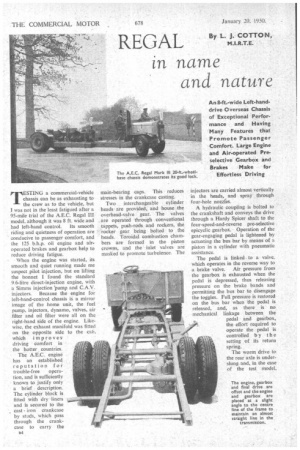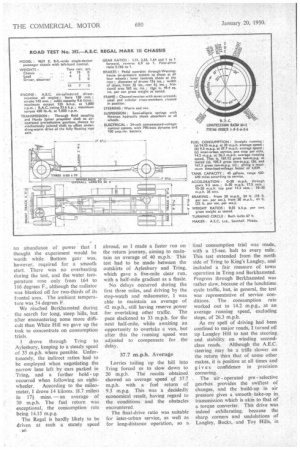REGAL
Page 38

Page 39

Page 40

Page 41

If you've noticed an error in this article please click here to report it so we can fix it.
in name
and nature
By L J. COTTON, m.i.R.T.E.
An 8-ft.-wide Left-handdrive Overseas Chassis of Exceptional Performance and Having Many Features that Promote Passenger Comfort. Large Engine and Air-operated Preselective Gearbox and Brakes Make for Effortless Driving
TESTING a commercial-vehicle chassis can be as exhausting to the crew as to the vehicle, but I was not in the least fatigued after a 95-mile trial of the A.E.C. Regal HI model. although it was 8 ft. wide and
had left-hand control. Its smooth riding and quietness of operation are conducive to passenger comfort, and the 125 b.h.p. oil engine and airoperated brakes and gearbox help to reduce driving fatigue.
When the engine was started, its smooth and quiet running made me suspect .pilot injection, but on lifting the bonnet I found the standard 9.6-litre direct-injection engine, with a Simms injection 'pump and C.A.V. injectors. Because the engine for left-hand-control chassis is a mirror image of the home unit, the fuel pump, injectors, dynamo, valves, air filter and oil filter were all on the right-hand side of the engine. Likewise, the exhaust manifold was fitted on the opposite side to the cab, which improves' driving comfort in the hotter countries.
The A.E.C. engine has an established reputation for trouble-free operation, and is sufficiently known to justify only a brief description. The cylinder block is fitted with dry liners and is secured to the east iron crankcase by studs, which pass through the crankcase to carry the 114 main-bearing caps. This reduces stresses in the crankcase casting.
Two interchangeable cylinder heads• are provided, and house the overhead-valve gear. The valves are operated through conventional tappets, push-rods and rockers, the rocker gear being bolted to the heads. Toroidal combustion chambers are formed in the piston crowns, and the inlet valves are masked to promote turbulence. The
injectors are carried almost vertically in the heads, and spray through four-hole nozzles.
A hydraulic coupling is bolted to the crankshaft and conveys the drive through a Hardy Spicer shaft to the four-speed-and-reverse pre-selective. epicyclic gearbox. Operation of the gear-engaging pedal is lightened by actuating the bus bar by means of a piston in a cylinder with pneumatic assistance.
The pedal is linked to a valve, which operates in the reverse way to a brake valve. Air pressure from the gearbox is exhausted when the pedal is depressed, thus releasing pressure on the brake bands and permitting the bus bar to disengage the toggles. Full pressure is restored on the bus bar when the pedal is released, and, as there is no mechanical linkage between the pedal and gearbox, the effort required to operate the pedal is controlled by the setting ofits return spring.
The worm drive to the rear axle is-underslung and, in the case of the test model, offset to the right-hand side. Engine and gearbox are also offset, and placed at a slight angle to the centre line of the frame to maintain almost a straight line in the transmission.
Air for brake and gearbox operation is supplied to a reservoir by a two-cylindered air-cooled compressor, which is driven through triple V belts and pulleys from the front propeller shaft. Air supplied to the compressor is drawn from the cab and the system includes a silencer, cleaner and anti-freeze unit.
The chassis was weighed before starting the trials, and the load of 6 tons 3/ cwt. imposed on the . unladen chassis Co represent a singledeck body plus a full complement of passengers was, in my estimation, erring on the generous side.
After leaving Southall, the A.E.C. was headed towards Rickmansworth, via Uxbridge and Denham. After a preliminary warming period, the driver kept the speedometer needle hovering over 80 k.p.h. (50 m.p.h.) w h er ev er conditions permitted. Although the quietness of the engine was noticeable, I was also aware that the vibration transmitted to the chassis was negligible. The engine suspension co mp rises A.E.C.Metalastik bushes, fore and aft, which are arranged for true axial movement.
Hill Hunting We left the main road before reaching Rickmansworth and branched off towards Chenies, a road which the map indicated to be hilly. The powerful engine made light work of the gradients encountered, and we rejoined the main road without meeting any hill requiring use of the lower indirect gears.
A route along the Chess Valley was then followed as far as Chesharn and an onslaught Was made on the Chilterns. The stiffest gradient to be found was White Hill, which is approximately three-quarters of a mile long and has a maximum slope of I in 8. The acute-angle approach to the hill presented no opportunity for a flying start, so the ascent was made from bottom gear, ' The engine responded to the occasion, and third gear was employed until the Tapley meter registered I in 10. A change to second gear was then made, but a reversion to the higher ratio was possible as soon as the gradient lessened to I in 20.
Returning to the 1 in -8 section, a stop start test was attempted in second gear. This would not normally be tried, but there appeared to be such
an abundance of power that I thought the experiment would be worth while Bottom gear was, however, required for a smooth start. There was no overheating during the test, and the water temperature rose only from 164 to 166 degrees F., although the radiator was blanked off for two-thirds of its frontal area. The ambient temperature was 54 degrees F.
We reached Berkhamsted during the search for long, steep hills, but after encountering none more difficult than White Hill we gave up the task to concentrate on consumption trials.
drove through Tring to. Aylesbury, keeping to a steady speed of 35 m.p.h. where possible. Unfortunately, the indirect ratios had to be employed when negotiating the narrow lane left by cars parked in Trin& and a further hold up occurred when following an eightwheeler. According to the mileometer, I drove 14 kiloms. (8.7 miles) in 17i mins. an average of 30 m.p.h. The fuel return was exceptional, the consumption rate being 14.15 m.p.g.
The Regal is hardly likely to be driven at such a stately speed . a6 abroad, so I made a faster run on the return journey, aiming to maintain an average of 40 m.p.h. This test had to be made between the outskirts of Aylesbury and Tring, which gave a five-mile clear run, with a half-mile gradient as a finale.
No delays occurred during the first three miles, and driving by the stop-watch and mileometer, I was able to maintain an average of 42 m.p.h., still having reserve power for overtaking other traffic. The pace slackened to 33 m.p.h. for the next half-mile, while awaiting an opportunity to overtake a van, but after this the running speed was adjusted to compensate for the delay.
37.7 m.p.h. Average
Lorries toiling up the hill into Tying forced us to slow down to '20 m.p.h. The results obtained showed an average speed of 37.7 m.p.h. with a fuel return of 9.3 m.p.g. This was a .decidedly economical result, having regard to the conditions and the obstacles encountered.
The final-drive ratio was suitable for inter-urban service, as well as for long-distance operation, so a final consumption trial was made, with a 15-sec. halt to every mile. This test extended from the north side of Tring to King's Langley, and included a fair measure of town operation in Tring and Berkhamsted. Progress through Berkhamsted was rather slow, because of the lunchtime cycle traffic, but, in general, the test was representative of service conditions. The consumption rate worked out to 14.2 m.p.g., at an average running speed, excluding stops, of 26.3 m.p.h.
As my spell of driving had been confined to major roads, I turned off up Langley Hill to test the steering and stability on winding second class roads. Although the A.E.C. steering may be a trifle slower on the return than that of some other makes, it is positive at all times and gives confidence in precision cornering.
The air operated pre selective gearbox provides the swiftest of changes, and the build-up in air pressure gives a smooth take-up in transmission which is akin to that of a torque converter. This drive was indeed exhilarating, because the sharp corners and undulations of Langley, Bucks, and Toy Hills, in
the Chippertield area, demanded -frequent use of the gearbox.
The short performance trials were made over a concrete-surfaced road between West End Lane and Greenford. To accelerate from rest to 30 m.p.h. in first, second and third gears took an average of 17.5 .secs. Top-gear acceleration was notably smooth, the time occupied to reach ' 30 m.p.h. from a rolling start being 26 secs..
When m ea s.0 ring stopping distances, the braking system 'showed a higher efficiency from 30 m.p.h. than from 20 m.p.h. A series of repeat tests failed to disprove this result, and it could only be assumed, that there was a time delay of approximately t sec. between the application of the -pedal and operation of the shoes.
The results showed the brakes to be efficient without erabbing or
being in any way dangerous. The stopping distance of 44 ft. from 30 m.p.h. is within the -standard required by public-service-vehicle operators in this country, a higher efficiency being considered dangerous to passengers
Running temperatures taken at the conclusion of the 95-mile trial were: Engine oil 126 degrees F., gearbox 112 degrees F., and rear, axle 153 degrees F.




















































































